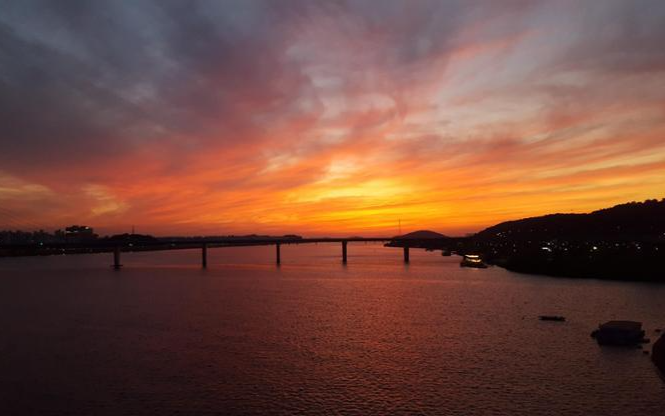Sunset in Seoul on June 15, 2020 – at the beginning of the covid pandemic. Robert Neff Collection
By Robert Neff
One of the least appreciated but arguably the most beautiful thing to see in Seoul is the evening sky – especially along the Han River. It is not uncommon to see crowds of people gathered along the river banks sipping coffee – and perhaps stronger drinks – while staring at the majestic sunset. For the young lovers, it is romantic; for the weary office worker, it is rejuvenating; and for the elderly, it is a reminder of just how insignificant we humans are when compared to the colossal might of the universe. But in the late fall of 1883, the red sky was an omen of change and a reminder of the Mother Nature’s devastating strength.
November 3, 1883, the port of Jemulpo (modern Incheon) was awash with brilliant colors and tremendous explosions – it was the Japanese emperor’s birthday. According to one eyewitness:
“[A] considerable amount of gunpowder was spent at this port, in honour of H.M. the Emperor of Japan, it being the Mikado’s birthday; at noon a thundering [cannonade] roared forth, and Roze Island anchorage was covered with smoke for some time; the ships of war Seiki Kan, Sapphire and Leipzig having fired a salute, the same ships of war, including the British Kestrel, had dressed ship in grand style as three Japanese sailing vessels anchored off Chemulpo. His Royal Korean Majesty’s Custom House was also gaily decorated with flags, and most of the Japanese residents had unfurled the banner of Dai Nippon over their houses, three Japanese sailing vessels in the inner harbour were most tastefully decked all over with flags and flowers, and made a very pleasing and picturesque impression.”
One can easily imagine the display of flags and naval firepower impressed the community, but the awe inspired by man was quickly eclipsed in the evening by Mother Nature.
Yun Chi-ho, a Korean working as an interpreter for the American legation in Seoul, somewhat off-handedly noted in his diary that in the “morning and evening, the sky is full of [a] red aura in the east and west.” It seems a rather benign observation, but these were no ordinary sunrises and sunsets.

Sunset in Seoul on June 10, 2019. Robert Neff Collection
According to an article published in The Atlantic in April 1884: “The strange heavens of the later autumn [of 1883], the fiery glow of sunrise and sunset, the brownish haze that girdles the sun all day, [were] phenomena so out of the range of common experience” that they could not be easily explained.
One eyewitness in Seoul described the sky as being wonderfully red for about one and a half hours to two hours after sunset and very similar to the appearance of the northern lights.
“Sometimes it was just a uniform, brilliant brightness, the initial center of which always lay where the sun had disappeared, [but] on other evenings the sun shot long-fingered rays of a darker color through the clouds, [and] on one evening there was an alternation between darker and lighter evening red colors likes a ceaselessly flowing vertically folded curtain.”
The Western observer and his peers viewed it “with delight every evening” believing it was a normal occurrence in Korea during the fall. However, they soon learned that the Korean population was greatly alarmed and stood in the streets staring at the sky. They “were restless because of the signs in the sky, …[believing] they meant turmoil, war and misfortune.”
In Jemulpo, an officer aboard the German warship, Leipzig, was startled to discover two magnificent meteors – one with a red tail and the other with a blue tail – in the night sky. These celestial visitors likely caused further unease amongst the people – according to our eyewitness, the fire that destroyed Gyeongbok Palace on December 19, 1876, may have been caused by a falling meteor or lightning. “The gods had brought misfortune upon [the palace] and [demonstrated] their displeasure through fire sent from heaven.”
After several days, the brilliant red sky was no longer a diary subject for Yun Chi-ho or our Western visitor. Frustratingly, the English-language newspapers in China and Japan failed to mention the brilliant red sky. The Japan Weekly Mail apparently thought articles about cats being stoned by mischievous boys, and crows stealing dogs’ bones were of more interest to its readers than beautiful but mysterious sunsets.
What was the cause of these sunsets? The Atlantic provided a clue when it printed part of a poem by William Cowper, an English poet of the 18th century.
“Fires from beneath, and meteors from above,
Portentous, unexampled, unexplained,
Have kindled beacons in the skies; …
And Nature with a dim and sickly eye
To wait the close of all;”
The brilliant red sunsets were part of the aftermath of the volcanic eruption of Krakatoa on August 27, 1883. For several months “the red sunsets and the mist-encircled noonday sun were very constant phenomena” but gradually they began to diminish prompting N.S. Schaler, to conclude his Atlantic article with:
“When this volcanic dust ceases to glorify our skies at dawn and eve, we shall part with what has probably been the most remarkable and picturesque accident to the earth’s physical life that has been known with the limits of recorded history.”
Although we do not have color photographs of these brilliant red sunsets, some believe we do have paintings. It has been suggested that Edvard Munch’s hauntingly beautiful but disturbing 1893 painting – “The Scream” – portrays the vivid red sunsets he witnessed in Europe following the volcanic eruption.
The beauty of the sunset is in the eye of the beholder and every generation lives in “strange times.”
Robert Neff has authored and co-authored several books, including Letters from Joseon, Korea Through Western Eyes and Brief Encounters.


